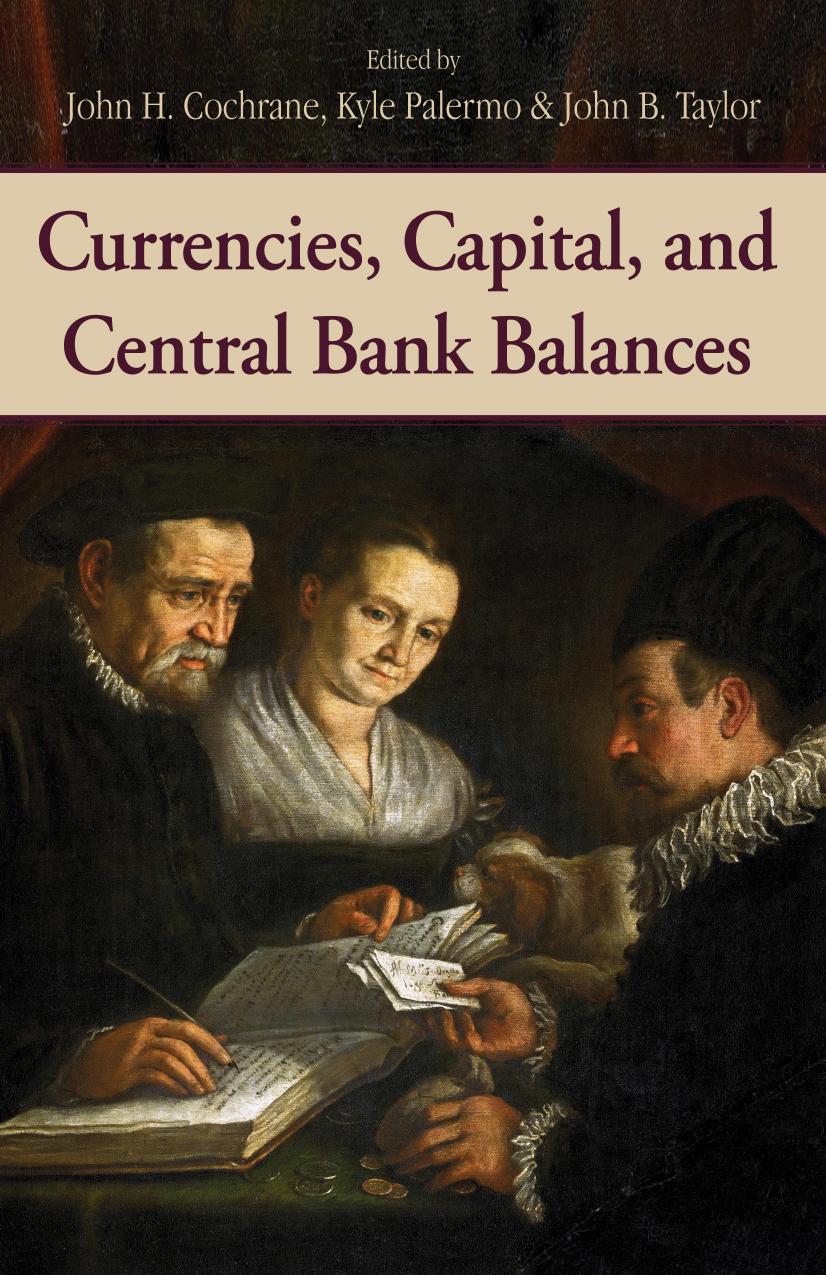Currencies, Capital, and Central Bank Balances by Cochrane John H.; Palermo Kyle; Taylor John B

Author:Cochrane, John H.; Palermo, Kyle; Taylor, John B.
Language: eng
Format: epub, pdf
Publisher: Hoover Institution Press
Published: 2019-02-16T16:00:00+00:00
FIGURE 7.1.3. Projected SOMA Domestic Securities Holdings: Alternative Liabilities Scenarios
Source: Federal Reserve Bank of New York (2018), Open Market Operations during 2017 (New York: FRBNY), https://www.newyorkfed.org/medialibrary/media/markets/omo/omo2017-pdf.
Note: Figures are as of year-end. Figures for 2010 to 2017 (shaded area) are historical settled holdings. Smaller and larger liabilities are based, respectively, on the 25th percentile and 75th percentile responses to a question about the size and composition of the Federal Reserve’s long-run balance sheet in the Federal Reserve Bank of New York’s December 2017 Survey of Primary Dealers and Survey of Market Participants. Projected figures are rounded. SOMA is System Open Market Account.
The figure illustrates that the Fed’s securities holdings are projected to decline about $400 billion this year and another $460 billion next year as Treasury and agency securities continue to roll off gradually from the Fed’s portfolio. The kink in each curve captures what the FOMC has referred to as the point of “normalization” of the size of the Fed’s balance sheet—that is, the point at which the balance sheet will begin to expand again to support the underlying growth in liabilities items such as Federal Reserve notes in circulation. All else being equal, greater longer-run demand for currency, reserve balances, or other liabilities implies an earlier timing of balance sheet normalization and a higher longer-run size of the balance sheet, as illustrated by the top line. And the converse—smaller demand for these liabilities and a later timing of normalization, illustrated by the bottom line—is also possible. In the three scenarios shown, the size of the Fed’s securities portfolio normalizes sometime between 2020 and 2022. That is quite a range of time, so as the balance sheet normalization program continues, the Fed will be closely monitoring developments for clues about banks’ underlying demand for reserves.
What will the Fed be monitoring as reserves are drained and the balance sheet shrinks? I would first like to emphasize that the Fed regularly monitors financial markets for a number of reasons, so I do not mean to imply that we will be doing anything that is very much different from our normal practice. As reserves continue to be drained, we will want to gauge how banks are managing their balance sheets in continuing to meet their LCRs, watching in particular how the distribution of reserve balances across the banking system evolves as well as monitoring any large-scale changes in banks’ holdings of other HQLA-eligible assets, including Treasury securities and agency mortgage-backed securities.
And on the liabilities side of banks’ books, we will be keeping our eye on both the volume and the composition of deposits, as there are reasons why banks may take steps, over time, to hold onto certain types of deposits more than others. In particular, retail deposits may be especially desired by banks going forward because they receive the most favorable treatment under the LCR and also tend to be relatively low cost.
Retail deposits have grown quite a bit since the crisis, especially in light of the prolonged period of broad-based low
Download
Currencies, Capital, and Central Bank Balances by Cochrane John H.; Palermo Kyle; Taylor John B.pdf
This site does not store any files on its server. We only index and link to content provided by other sites. Please contact the content providers to delete copyright contents if any and email us, we'll remove relevant links or contents immediately.
International Integration of the Brazilian Economy by Elias C. Grivoyannis(74527)
The Radium Girls by Kate Moore(11616)
Turbulence by E. J. Noyes(7695)
Nudge - Improving Decisions about Health, Wealth, and Happiness by Thaler Sunstein(7238)
The Black Swan by Nassim Nicholas Taleb(6761)
Rich Dad Poor Dad by Robert T. Kiyosaki(6174)
Pioneering Portfolio Management by David F. Swensen(6078)
Man-made Catastrophes and Risk Information Concealment by Dmitry Chernov & Didier Sornette(5644)
Zero to One by Peter Thiel(5487)
Secrecy World by Jake Bernstein(4387)
Millionaire: The Philanderer, Gambler, and Duelist Who Invented Modern Finance by Janet Gleeson(4089)
The Age of Surveillance Capitalism by Shoshana Zuboff(3980)
Skin in the Game by Nassim Nicholas Taleb(3965)
The Money Culture by Michael Lewis(3843)
Bullshit Jobs by David Graeber(3826)
Skin in the Game: Hidden Asymmetries in Daily Life by Nassim Nicholas Taleb(3720)
The Dhandho Investor by Mohnish Pabrai(3560)
The Wisdom of Finance by Mihir Desai(3523)
Blockchain Basics by Daniel Drescher(3326)
